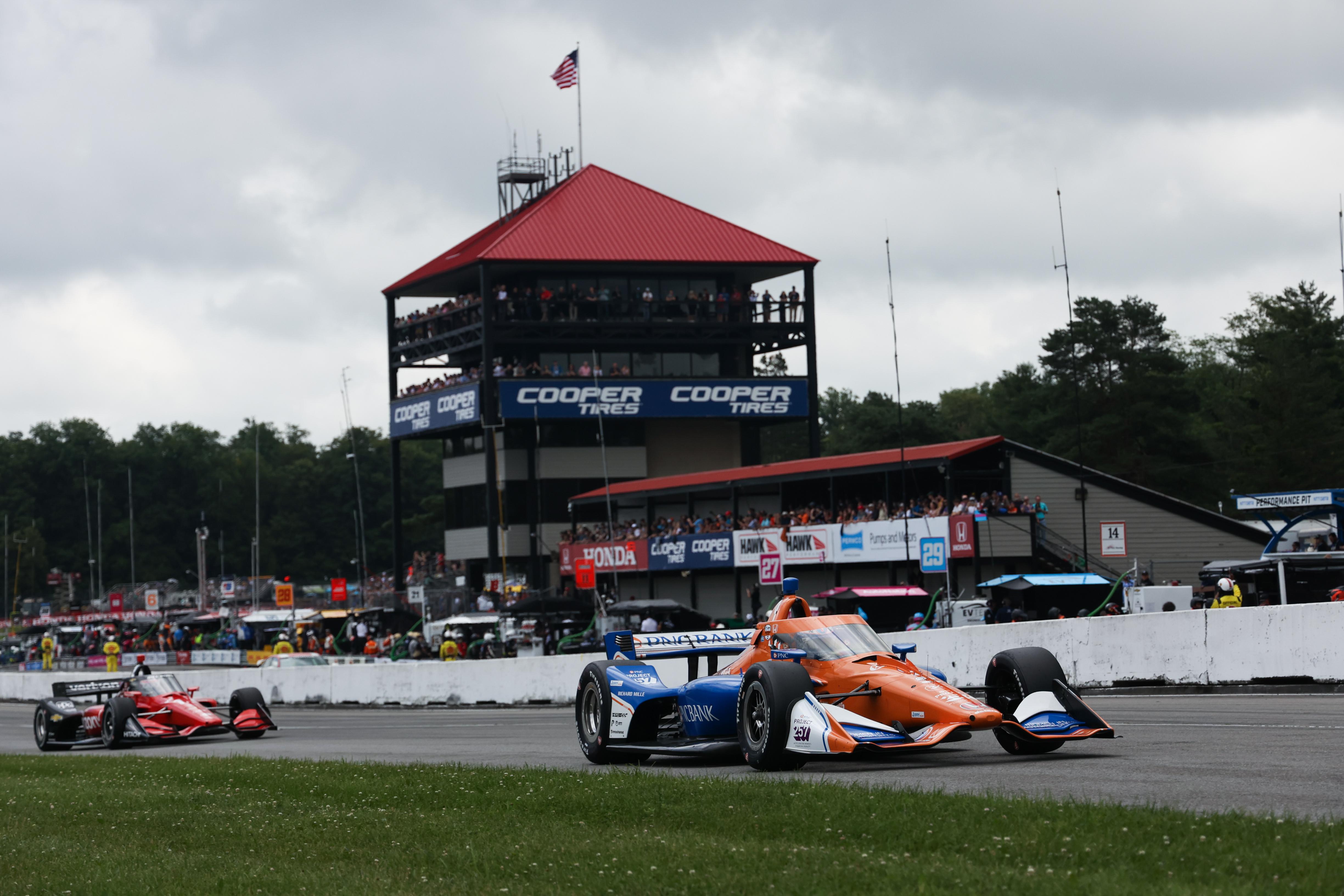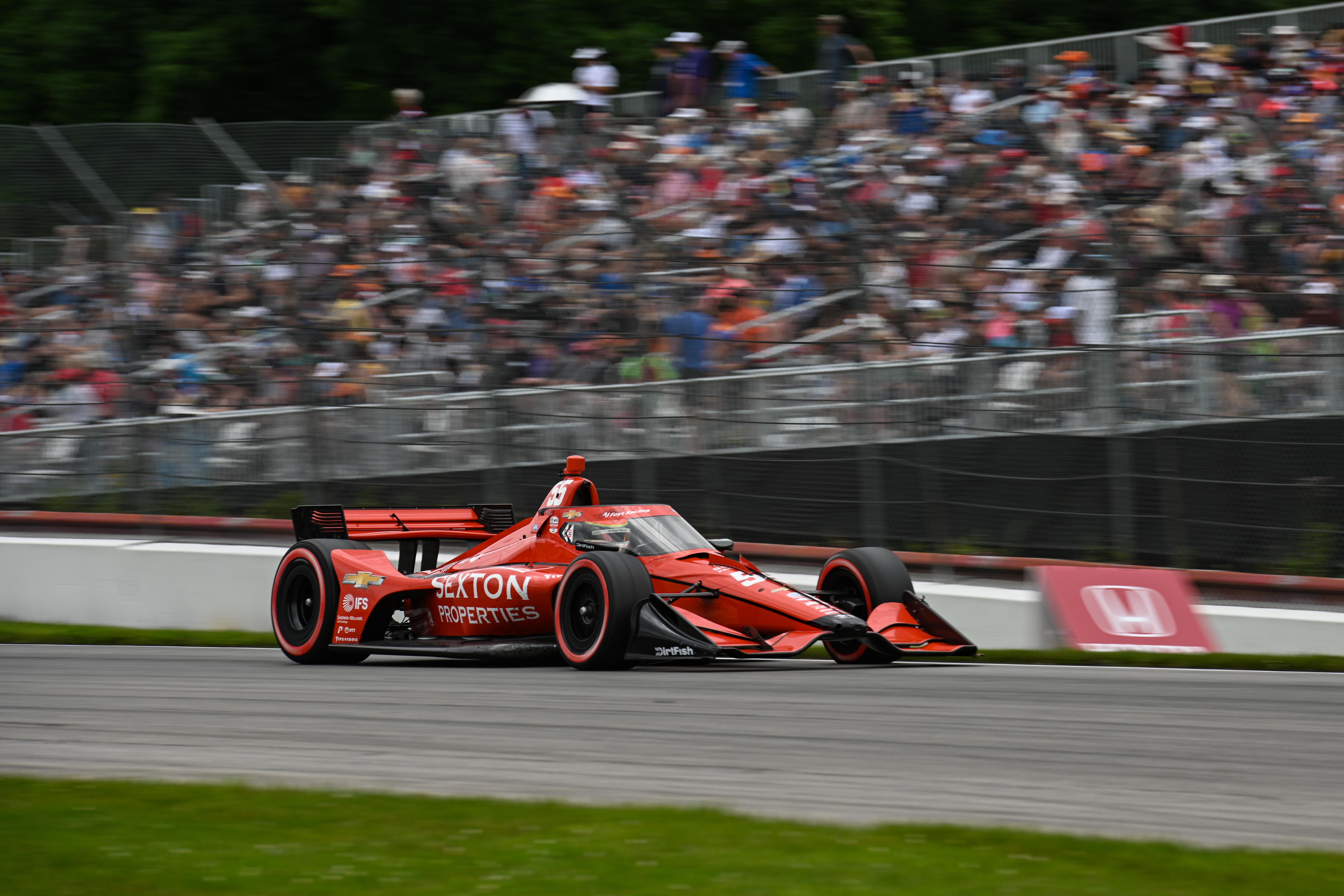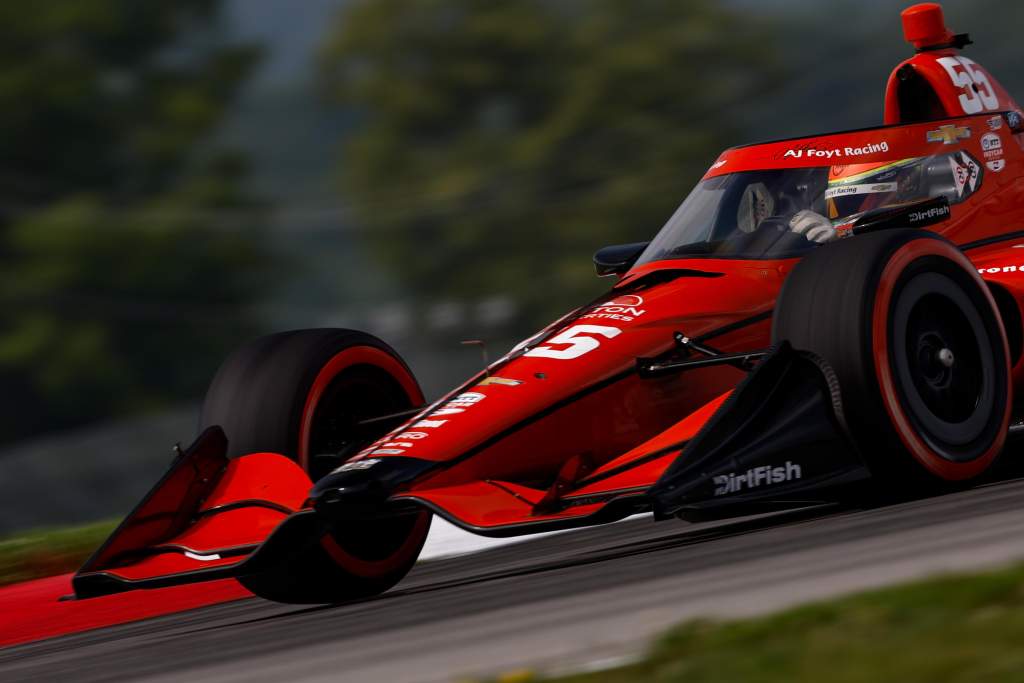Many of IndyCar’s top drivers criticised rookie Benjamin Pedersen at Mid-Ohio and called for a change to the series’ blue flag rules.
In IndyCar, drivers who are about to go a lap down are free to fight the leader to try to stay on the lead lap, unlike in other series such as Formula 1 where a blue flag would signal that the leader should be let through.
Pedersen aggressively raced eventual winner Alex Palou mid-race, using his push to pass overtake boost to keep the runaway points leader at bay, forcing Palou wide at every opportunity. Palou lost over four seconds to the chasing Colton Herta and used more fuel and tyre life than he would otherwise have done trying to get past.
The rules aren’t the problem
Matt Beer
I definitely wasn’t arguing this when, as a fervent 16-year-old Alex Zanardi fan, I was beginning a lifelong grudge against backmarker PJ Jones for stuffing my hero into the Vancouver wall while he was leading and still in CART title contention as a rookie in 1996.
But I absolutely love the American motorsport tradition of racing hard to stay on the lead lap and would hate to see it get anywhere near the ‘see a blue flag and capitulate’ European/F1 culture.
With the way caution-period timing and clever strategies can invert a NASCAR or IndyCar race, scrapping to stay on the lead lap is absolutely valid.
Or at least it is if you’re remotely competitive. Whether a driver and team in Pedersen’s and Foyt’s position stands to gain much by taking the gloves off against Palou is a moot point.
To me, this is just about policing poor driving rather than the concept of the rules around being lapped.
It’s asking a lot of stewards’ nuanced handling of incidents, but there’s a difference between a driver making responsible efforts to defend – or regain – their place on the lead lap and blocking/clumsy racing that would be penalty-worthy if it was for an actual position so is unacceptable regardless of whether the car’s being lapped or not.
I don’t think Pedersen deserved a sanction by that measure, but I accept he didn’t need to make the leaders’ lives that difficult.
So yes, the threshold for making good racing choices should be higher if a car’s being lapped and poor driving should be judged more harshly if it happens while being lapped. But please don’t take away this fascinating subplot of American races altogether. Even though I still haven’t forgiven Jones.
Why Pedersen enraged the 2023 leaders
“I know the rules, but at the same time it’s very frustrating when you are leading and you try to open the gap and they don’t let you pass, but they are using the overtake [push to pass button], like 20, 30 seconds a lap, to try to stay up front,” Palou said after the race.
“On top of that, once you are side-by-side, that they are so aggressive defending. Obviously it’s really frustrating when you are leading.
“I knew I had to get past also because you are using more overtake, you are using more fuel, you are using more tyres, and you’re not able to do the race you want just because of a backmarker car that wants to stay on the lead lap.
“The issue is that once you pass them, they let everybody pass because they already lost the lap; right? [note: Pedersen did not do this!]

“So, yeah, it’s frustrating. I know it’s the rules. I would like it to change. It’s not going to change. So, yeah, whatever. I’m more relaxed now [after the race].”
Pedersen’s best race lap was 1.3 seconds slower than Palou’s, while Palou went one second quicker than Pedersen on the next lap after passing him then almost two seconds quicker the following lap.
Will Power – third at Mid-Ohio – is never a driver scared to offer his thoughts on series rules and be outspoken against IndyCar if he disagrees with something.
The Penske driver and Palou’s runner-up Ganassi team-mate Scott Dixon both discussed the blue-flag rule in their post-race press conference, with Power raising the subject unprovoked – and having seemingly been unaffected by it during the race.
“I think that the blue flag rule, it’s crazy,” he said.
“You use push-to-pass up and have to race somebody that’s going to be a lap down like you’re racing for position.
“The series is so tight and competitive, and everyone is so good now that I think we could have a blue-flag rule. It’s not like we have yellows constantly, and you’re going to get your lap back.
“Maybe they do it in the second half of the race, but it’s ridiculous when a leader gives up 10 seconds.
“I think you [talking to Dixon] were five seconds down the road, I closed it right up. Probably would have overtaken you if I didn’t get held up on going a couple of laps longer.

“We should have a talk about it, I think. I don’t know, what do you think?”
Dixon smiled and replied: “We do [talk about it], every year.”
“We tell them every year,” continued Power.
“They’re, like, ‘Yeah, yeah, no, we hear you’. Crickets.”

Where Pedersen’s defence arguably became more of an issue was later in the race when he was a lap down and no longer the first car a lap down, so with little to gain from a caution, but still defended aggressively against cars fighting for a top five and a top 10.
Penske’s Scott McLaughlin, who finished fifth, was one of those drivers. He angrily confronted Pedersen after the race.
Scott McLaughlin was not a fan of Benjamin Pedersen after this one.#Honda200 #IndyCar pic.twitter.com/97ybzF1pjo
— Christopher DeHarde (@CDeHarde) July 2, 2023
Asked what he had said, McLaughin replied: “I just said he’s not going to make any friends if he holds people up. He’s not even in our race.
“I get he’s in a race of his own. We lost three or four seconds in that exchange because of the #55 [Pedersen]. It’s give or take in this series and if I’m a lap down and the #55 is behind me then who knows what I’m going to do.”
McLaughlin was only two seconds off a podium at the end of the race so you can see why his opinion that he lost three or four fighting a car a lap down would frustrate him.

Pedersen also held up a train led by Pato O’Ward, in which his engineer Will Anderson said that he had asked common engine supplier Chevrolet for help in moving Pedersen out of the way but Pedersen was ‘unresponsive’.
There were other drivers on the receiving end, as David Malukas criticised Pedersen post-race.
“He was blocking, he was trying to block for Ferrucci. If I was in that position I would never do that,” he told NBC, referring to Pedersen allegedly trying to hold up Malukas to give Pedersen’s Foyt team-mate a Santino Ferrucci a chance to catch him.
“You’re just making enemies, he’s definitely made an enemy out of me. He was just trying to ruin everybody’s races for no reason. I don’t think that’s how you should drive.”
Pedersen was within rules – but short-sighted
Jack Benyon

I’m a bit concerned this article might so far be unbalanced with the amount of flack Pedersen has received. I actually feel like his battle with Palou was fine; it was hard but fair racing to stay on the lead lap. It wasn’t ideal for Palou, but within the rules – even if Pedersen did hold up the leader for around 10 laps.
One thing we do have to consider, because nothing Pedersen did was against the rules, is that his team could have been telling him to battle that hard to avoid being lapped. Because Pedersen’s a rookie, it might be hard to know when to follow those instructions and when to yield based on your own judgement. So we should consider that before criticising Pedersen too harshly.
I’d be fine if a solution was for IndyCar to say, ‘We’re going to let cars about to be lapped race, but if the pace is too slow we’ll blue flag them’, but that might open the door for people to accuse IndyCar of being biased to the driver it does or doesn’t throw the flag for! Pedersen was clearly holding up Palou, but how slow does a driver need to be to be deemed fast or not fast enough?
So in summary, I felt Pedersen’s racing of Palou was hard but fair. It won’t have endeared Pedersen to Palou and he’ll have to accept that the next time his race is in Palou’s hands, but that’s a reasonable risk to take.

What wasn’t a reasonable risk to take was later in the race when Pedersen effectively drove multiple cars off the track, or at least way off line, defending when he wasn’t even the first car a lap down. In those situations he had little to gain and a lot to lose by pissing off half the paddock.
If he also elected to ignore engine manufacturer Chevy’s request on McLaren’s behalf for him to let O’Ward through, I can’t imagine that was well received. If that was the case, Pedersen ought to remember who is responsible for his simulator time as well as his engine power.
Pedersen’s actually done a pretty decent job this year given his junior formula resume and the fact he’s driving for a Foyt team in transition. But this should be a big lesson learned and one that likely comes back to bite him in the form of other drivers not affording him room in future on-track battles.
Race control needs to step in when you have a driver acting this way when not fighting to stay on the lead lap. Disabling push to pass and being more aggressive with blue flags is a must for me.
Especially because Pedersen’s road block scrunched up the field and ruined quite a few drivers’ chances of a stronger finishing position. For anyone off strategy and not being held up, they had free rein of in-laps and out-laps and clean air to make up time on those caught in the train. It’s one of the reasons O’Ward got as high as he did on a three-stop strategy, although his scintillating pace was the main one.
IndyCar is too good and too competitive now to let those not quick enough impact other drivers’ races like this. It could end up costing race wins and championships, although that’s a moot point with Palou’s current form…
What do top drivers want to happen?
All of this criticism begs the question: What should be done to change the situation?
That was something Power was asked about after the race.
“I think actually the problem is it takes a lot of people to police that because if there’s a blue-flag rule and the first guy passes and then you’ve got to have a command blue for everyone, but I think if everyone just understood, if you get the blue flag, you have to let the driver go within the lap [it would work].
“That, I think, is their issue: the amount of people in race control that would have to police that. It becomes a bit difficult, but we’re at the stage where this competition is so tough maybe we have to add some people to do that.”

“I think disabling the OT [overtake boost] would be the first…,” Dixon added, before Power interjected: “The disabling of the OT, and that was the one they say, ‘Well, how do we police?’
“Do we disable it for everyone after that? It sounded like that was a big problem, but it’s not like a tonne of people go a lap down anymore anyway.
“Disabling the push-to-pass would be a big step if you are going to be a lap down, yeah.”
Ultimately it’s tough because there’s no obvious solution that doesn’t involve more resources and race micro-management for IndyCar, for an issue that doesn’t crop up so much.

And at street races in particular, drivers can go from fighting to stay on the lead lap or even laps down to winning the race, the most high-profile example being Marcus Ericsson in Nashville in 2021.
But the difference there was Ericsson always had the pace to win that race. Pedersen was never going to win even if he was placed at the front of the field through strategy mayhem at Mid-Ohio.
Pedersen has every right to fight for every position and point when the points at the end of the year can mean a big prize payout. But IndyCar has to be careful that this situation doesn’t escalate.






